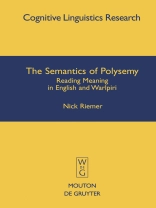This book, addressed primarily to students and researchers in semantics, cognitive linguistics, English, and Australian languages, is a comparative study of the polysemy patterns displayed by percussion/impact (‘hitting’) verbs in English and Warlpiri (Pama-Nyungan, Central Australia).
The opening chapters develop a novel theoretical orientation for the study of polysemy via a close examination of two theoretical traditions under the broader cognitivist umbrella: Langackerian and Lakovian Cognitive Semantics and Wierzbickian Natural Semantic Metalanguage. Arguments are offered which problematize attempts in these traditions to ground the analysis of meaning either in cognitive or neurological reality, or in the existence of universal synonymy relations within the lexicon. Instead, an interpretative rather than a scientific construal of linguistic theorizing is sketched, in the context of a close examination of certain key issues in the contemporary study of polysemy such as sense individuation, the role of reference in linguistic categorization, and the demarcation between metaphor and metonymy.
The later chapters present a detailed typology of the polysemous senses of English and Warlpiri percussion/impact (or P/I) verbs based on a diachronically deep corpus of dictionary citations from Middle to contemporary English, and on a large corpus of Warlpiri citations. Limited to the operations of metaphor and of three categories of metonymy, this typology posits just four types of basic relation between extended and core meanings. As a result, the phenomenon of polysemy and semantic extension emerges as amenable to strikingly concise description.
Table of Content
Chapter 1. Cognition and linguistic science
1. Introduction
2. Meaning and interpretation
3. Meaning and conceptualization: Cognitive Semantics
Chapter 2. Meaning, definition, and paraphrase
1. NSM and meaning
2. Definition and semantic theory
3. Grounding meaning
4. NSM-specific issues
5. More general issues
6. Implications
Chapter 3. Polysemy and the evidence for semantic facts
1. Introduction
2. Polysemy, monosemy and the natural tendency of semantic description
3. Proposed evidence of semantic structure
4. Lexical categorization, semantic relations and referent typicality
Chapter 4. Metaphor, metonymy and the theory of polysemy
1. Introduction
2. The present account
3. The basic P/I scenario
4. Four types of semantic ‘extension’
5. Metaphor and metonymy in semantic extension
Chapter 5. Applications I: English
1. Introduction
2. The domain of P/I in English
3. Sources of examples
4. Some methodological preliminaries
5. Polysemous extensions of English P/I verbs
6. Summary of means of extension: strike
Chapter 6. Applications II: Warlpiri
1. Introduction
2. A brief grammatical sketch
3. Three types of ‘polysemy’
4. Result Orientation in Warlpiri verbs
5. The domain of P/I in Warlpiri
6. Pakarni
7. Pinyi
8. Luwarni
9. Pantirni
10. Pajirni
11. Katirni
12. Parntarni
Chapter 7. Conclusion: description and explanantion in semantics
References












